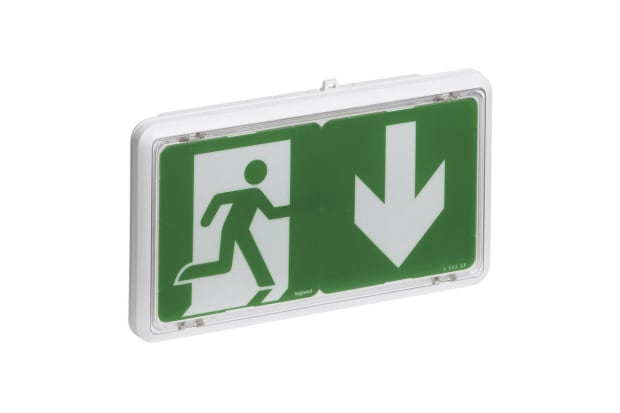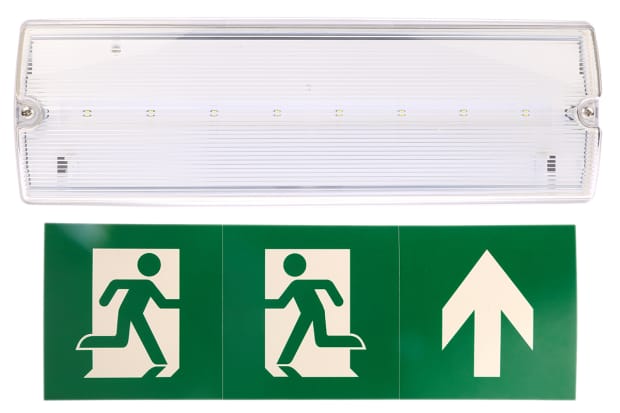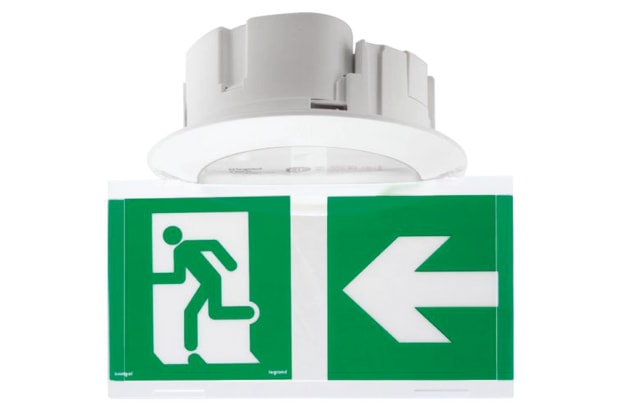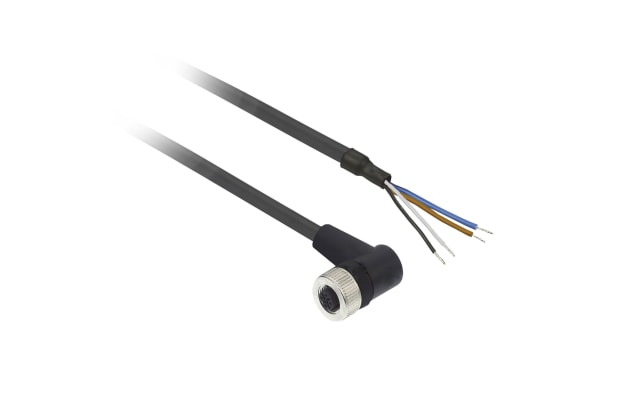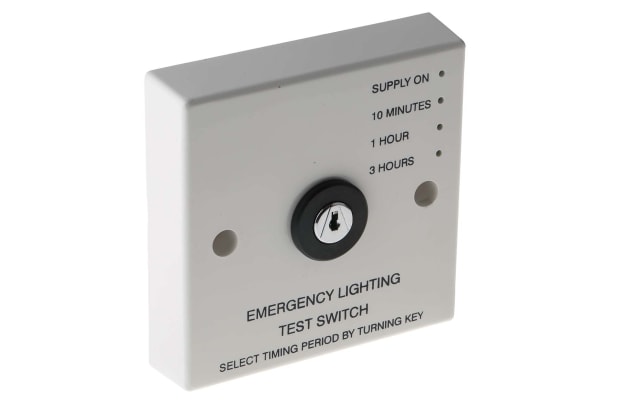- Published 17 Jan 2023
- Last Modified 20 Feb 2024
- 7 min
Safety & Emergency Lighting Guide
Understand all you need to know about emergency lighting regulations and discover how to test emergency lights.

What is Safety & Emergency Lighting?
Safety and emergency lighting provide illumination in the event of standard lighting supply failure. This type of lighting can be either standby lighting or emergency escape lighting. Standby lighting is essentially a backup used in the event of normal mains supply failure, whereas emergency escape lighting is designed to assist with safe exit.
Health and safety lighting is designed for use in the event of an emergency. These lights are highly visible and help to direct people out of the building and away from danger. They are typically powered by batteries mounted in an emergency luminaire or are wired into an emergency fitting network. This ensures that emergency lights can work even if the standard power supply fails.
What is the Difference Between Maintained and Non-Maintained Emergency Lighting?
The difference between maintained and non-maintained emergency lighting is straightforward, as explained below:
Maintained Emergency Lighting
This is designed for continuous lighting and will continue to be operational in the event of power failure. It can act as a standard light fitting under everyday circumstances but can provide essential backup in the event of an emergency or power outage. Maintained emergency lighting is typically used in busy public places such as cinemas and shopping centres.
Non-Maintained Emergency Lighting
This is lighting only designed to activate in the event of power failure. These lights are typically wired into the standard lighting circuitry but are intended to react to power failure, ensuring emergency lighting and exit routes stay lit. Non-maintained emergency lighting is normally used in offices and workplaces.
How Does Emergency Lighting Work?
For the majority of the time, emergency lights are connected and continuously charged to the building’s main electrical supply. If a power outage occurs or a breaker trips, the light is activated, and it will illuminate.
However, these lights also feature integrated batteries which act as backup sources of power in the event of failure to the main supply. These batteries are typically charged from the main power supply and are designed to power the light for a sustained period in the event of an emergency. Most emergency lighting is designed to last for a duration of three hours, but this can vary between fixtures.
Why are Emergency Lights Provided?
Emergency lights are essential for safety reasons and their presence is also mandatory in commercial and industrial premises. Safety lighting can help to protect individuals within a building in the event of an emergency, lighting key areas and showing the best route out of the building.
The importance of safety should never be overlooked and placing emergency lights at strategic points throughout the building is essential. Emergency lights promote safety and they can prove to be invaluable in the event of an emergency such as a fire or power outage.
How to Wire Emergency Lights
Before you begin any work, you must ensure that the breaker the emergency lighting is connected to is tripped to make the circuit safe and prevent the risk of electrical shock or injury. Additionally, guidance for installing any given emergency light may be available from the manufacturer. Make sure to familiarise yourself with any instructions or guidelines before starting work.
The basic process of how to wire emergency lights is as follows:
- Make the circuit safe for work to be carried out (as detailed above)
- Identify the voltage of the connection which will be made to the safety light fitting
- Examine the unit connections
- Connect the common wire and the right voltage wire for the connection voltage to the electrical conduit
- Connect the ground wire
- Switch the circuit on and give the battery sufficient charging time
- Test the unit to ensure full functionality
Incorrect emergency light installation can be hazardous and could result in damage to the unit, transformer, or circuit board. As a result, the task should only be completed by fully trained professionals.
Another point to consider is the mounting of the fixture. As a general rule, the unit will typically be fully or partially mounted before the emergency lighting wiring is connected. Various fitting types are available for emergency lights, so make sure to choose the most effective type for your particular model.
Common fitting types include:
Emergency Lighting Regulations
Various regulations governing emergency lights, including their use and testing, are in place to ensure safety lighting is as effective as possible. As emergency lighting is so critical to safety, regulations and recommendations surrounding it are key to ensuring lighting fixtures and circuits are functioning correctly at all times.

What is the Legal Requirement for Emergency Light Testing?
BS 5266-1 is a British standard and code of practice for emergency lighting. It outlines the duties of the ‘responsible person’ and focuses on the functionality of lighting fixtures and circuits. The standard also provides clear guidance on installing emergency lighting, focusing on ensuring safety if standard lighting or electrical supply is interrupted.
It provides clear standards to work towards and is suitable for use by both electrical engineers and professionals, as well as employers and landlords. The standard promotes understanding of emergency lighting and its importance and provides recommendations for performance, installation, and upkeep.
Emergency Light Testing
Regularly testing emergency lights is important as it ensures the fixtures are working as expected. Emergencies or loss of supply can be sudden and unexpected, so your emergency lights must be functioning correctly and always available in case they are needed.
How to Test Emergency Lights
Some safety and emergency lights, such as luminaires, can complete self-testing. However, the majority of emergency lights must be manually tested. Tests can be carried out by the ‘responsible person’ or a qualified electrician and all checks should be documented.
One important consideration to bear in mind is that your system will be vulnerable after a full annual check has been completed. The backup battery will take time to recharge post-testing, so be sure to assess the risk before carrying out testing. As a result of this, completing testing at low-risk times (such as out of standard working hours, where possible) is usually preferred.
Monthly Checks
Standard monthly checks should be carried out by following the steps below:
- Switch off the mains power to the emergency light fixture
- Some units may have a separate switch installed which allows for emergency lights to be tested without the need to turn off all power
- Visually inspect all emergency lights to ensure they are functioning as expected
- Document any issues and ensure these are investigated further
- Record the full results of the test
In addition to these monthly checks, an annual check should also be completed. This should involve:
- Switch off the mains power to the emergency light fixture
- Ensure all the emergency lights are lit up, as per the monthly checks
- Leave the power switched off for the full duration of the light’s rated period (typically three hours, but this can vary between units so make sure you are aware of the rated period beforehand)
- If any lights fail before the rated period is up, the back-up battery may need replacement
- Record all results of the test
Key Products
Emergency Lighting
Shop emergency lighting from a range of leading brands, with various types and variants available.
Conversion Kits
Browse emergency light conversion kits and discover the benefits that they can bring to your fixtures.
Replacement Parts
From replacement parts to key accessories, shop the full range online today with RS.
Test Switches
Emergency light test switches can enable easy testing of safety lighting. Shop online today.
